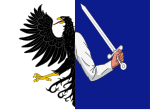Tyrone House
| Tyrone House | |
|---|---|
 | |
| General information | |
| Type | House |
| Architectural style | Georgian, Palladian |
| Classification | Derelict |
| Town or city | Kilcolgan, County Galway |
| Country | Ireland |
| Coordinates | 53°12′25″N 8°54′34″W / 53.207019°N 8.909472°W |
| Estimated completion | 1779 |
| Technical details | |
| Material | limestone |
| Floor count | 3 over basement |
| Design and construction | |
| Architect(s) | John Roberts |
| Developer | Christopher St.George |
| Known for | Inspiration for the book by Edith Somerville, The Big House of Inver |
| [1] | |
Tyrone House in County Galway is a ruined manor house, built in the 1770s on a promontory by the estuary of the Kilcolgan river, about 2 miles (3 km) from the village of Kilcolgan, County Galway, Ireland.
The house was destroyed by the local Irish Republican Army (IRA) unit during the Irish War of Independence.
History
[edit]Tyrone House, County Galway, was built in 1779.[2] It should not be confused with Tyrone House, Marlborough Street, Dublin, a townhouse designed by Richard Cassels for The 1st Earl of Tyrone of the 3rd creation in 1740.[3]
Writing in the 1780s, Daniel Augustus Beaufort described the house as '‘large and new but very bleak and too high'.[4]
Its original owner was Christopher St. George, scion of an old Norman Galwegian family.[2] The house was reputedly designed by John Roberts (1712/14–1796) of Waterford, who also designed Moore Hall in County Mayo in a similar style.[5] The St. George family at the time owned much of the area around Kilcolgan.[6] Arthur French St. George was described as a resident proprietor in 1824.[7]
In 1912, Tyrone House was described as "rather dilapidated" by visitor Violet Martin. It served as an inspiration for the novel "The Big House at Inver" by Edith Somerville, published in 1925.[6]
The house was destroyed by the local IRA unit during the Irish War of Independence in 1920[6] due to rumours that it was going to be used by the Black and Tans as an infirmary. The house was uninhabited at the time, except for a bed-bound caretaker who was taken from the house in his bed and left in another building on the premises before the main house was set alight.
References
[edit]- ^ "Tyrone House". The Irish Aesthete. Retrieved 9 August 2021.
- ^ a b "National Inventory of Architectural Heritage - Tyrone House, County Galway". Department of Arts, Heritage & the Gaeltacht. Retrieved 9 January 2014.
- ^ "Tyrone House (Department of Education), Marlborough Street, Dublin 1, DUBLIN". Buildings of Ireland. Retrieved 3 August 2021.
- ^ "Tyrone House exterior and interior – Irish Architectural Archive". www.iarc.ie. 25 November 2022. Retrieved 26 June 2023.
- ^ Department of the Environment, Heritage and Local Government (2011). An Introduction to the Architectural Heritage of County Galway. ISBN 978-1-4064-2534-5.
- ^ a b c Korff, Anne (1987). Kiltartan Country, South Galway - A Ramblers Guide and Map. Tir Eolas. ISBN 978-1-873821-11-4.
- ^ "Landed Estate Database: Estate - St George (Tyrone House)". NUI Galway. Retrieved 19 January 2018.
External links
[edit]

